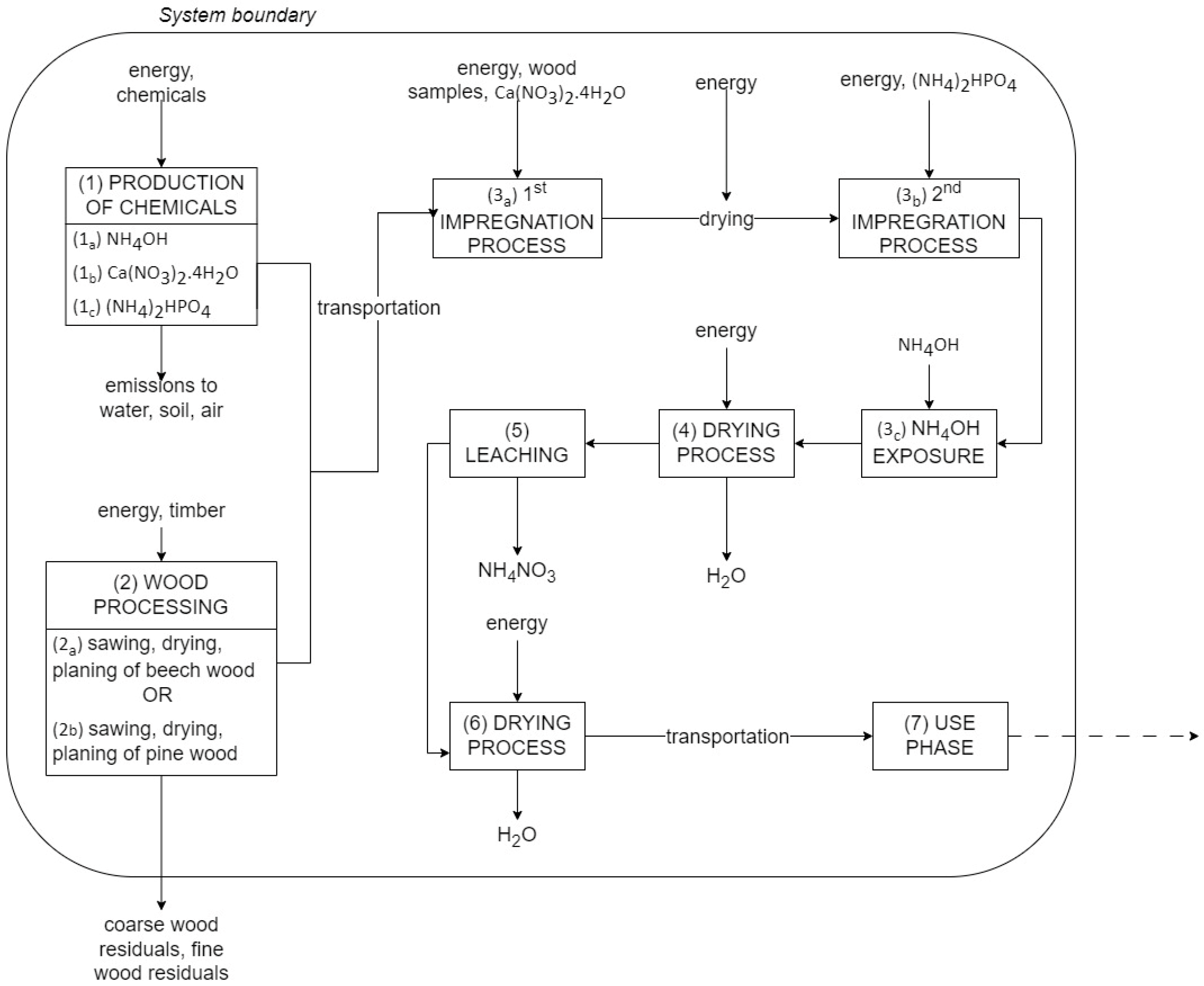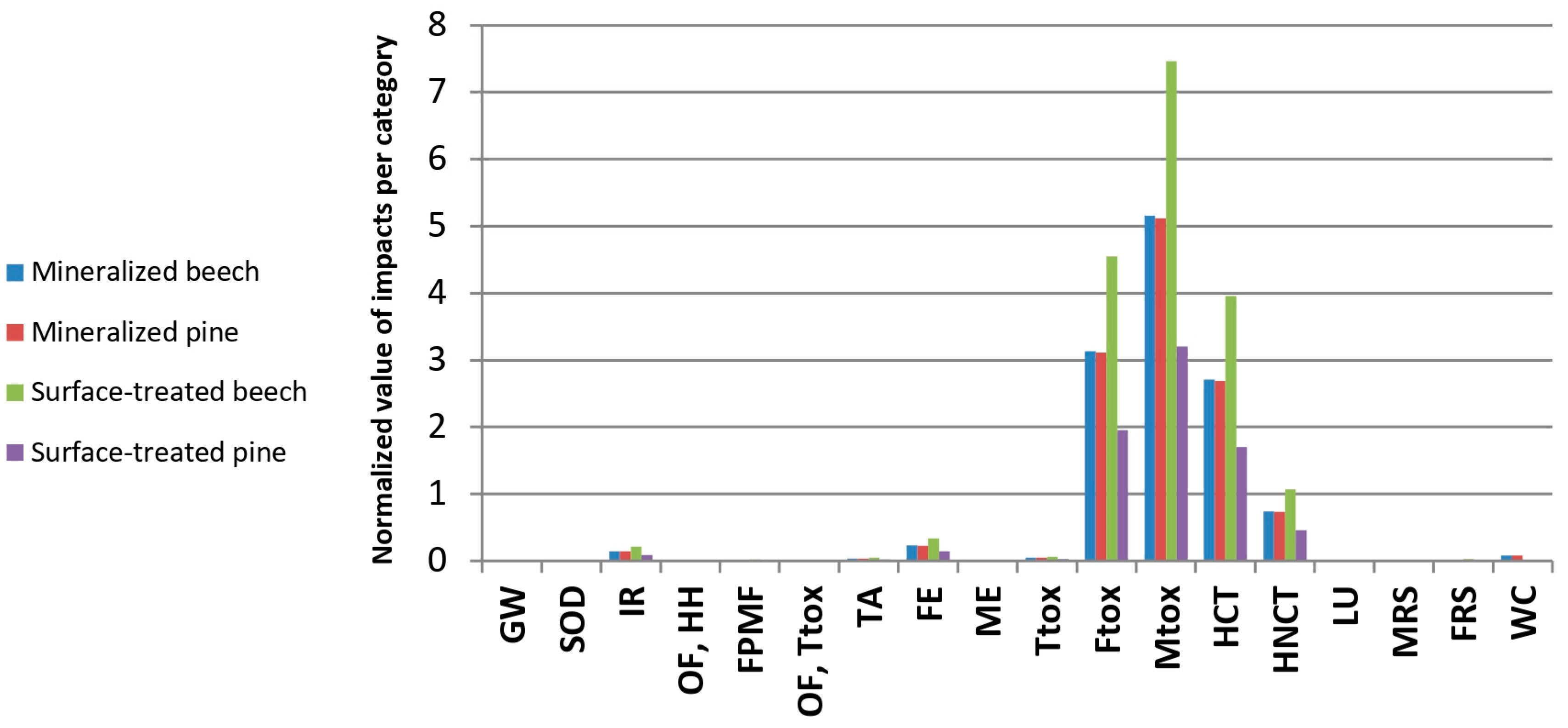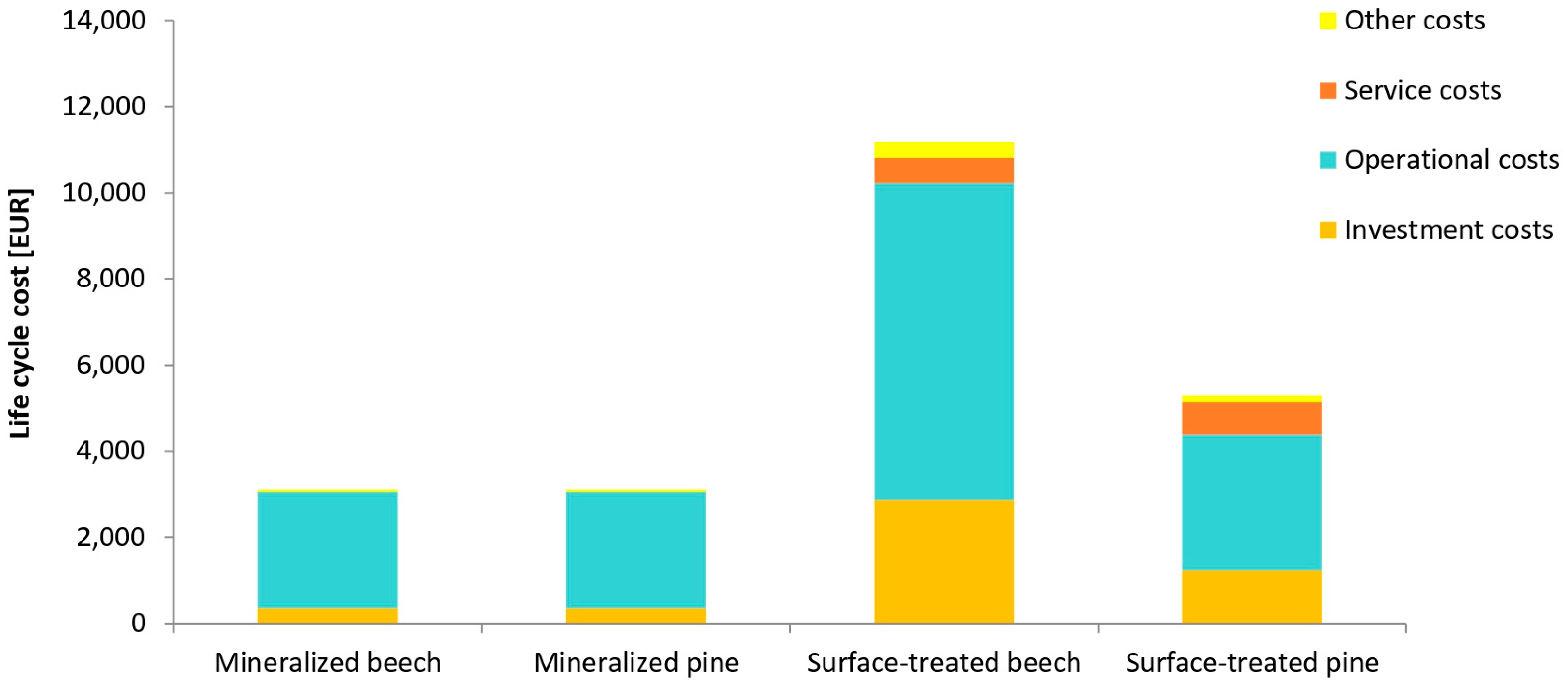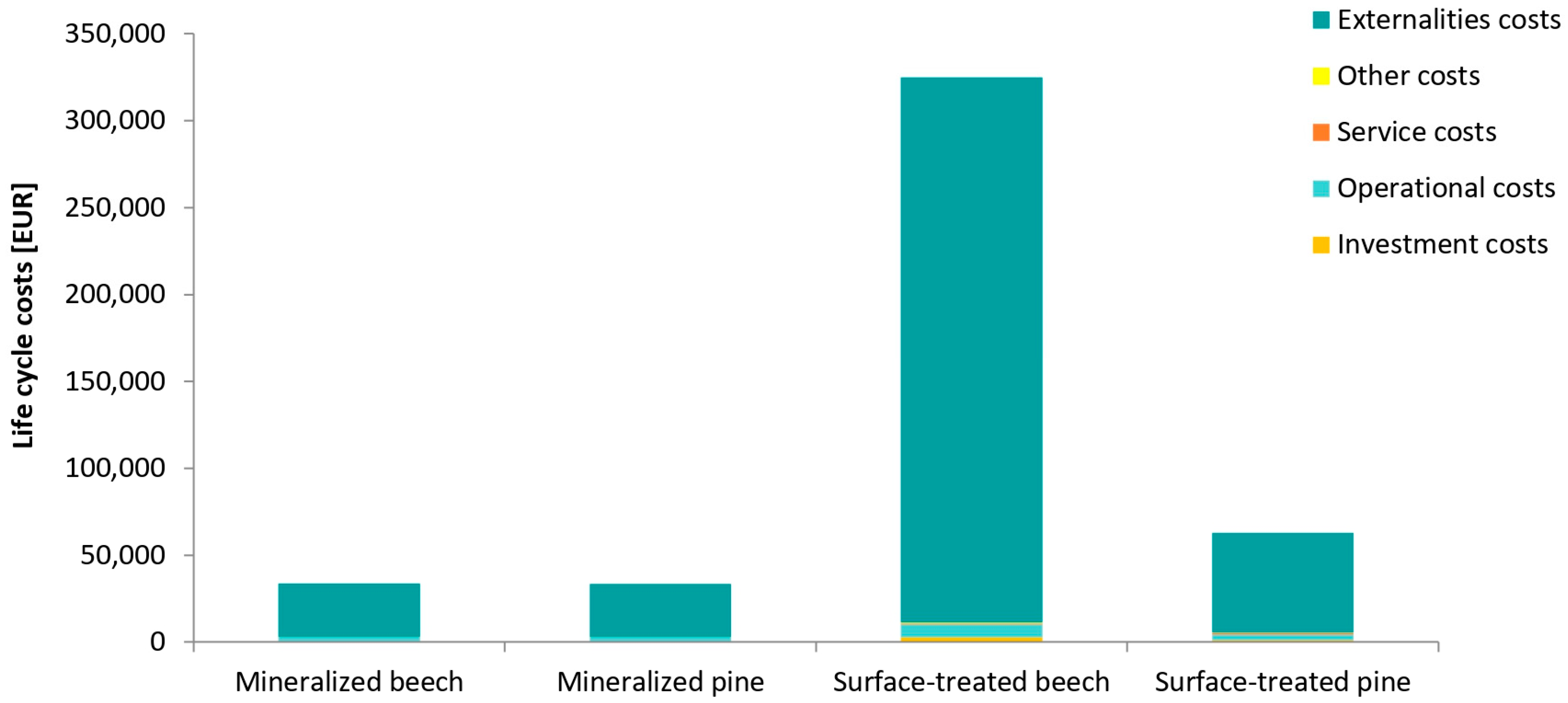Environmental and Economic Impacts of Hydroxyapatite Mineralized Wood: LCA and LCC Analysis
Abstract
:1. Introduction
2. Materials and Methods
2.1. Goal and Scope of the LCA Study
2.2. Life Cycle Inventory—LCI
2.3. Cost Evaluation—LCC
3. Results
3.1. The Results of LCA Analysis (LCIA)
3.2. The Results of LCC Analysis
4. Discussion
4.1. Discussion on LCA Results
4.2. Discussion on LCC Results
5. Conclusions
Author Contributions
Funding
Data Availability Statement
Conflicts of Interest
References
- Kraigher, H.; Humar, M.; Gričar, J. Gozd in les: Gozd prihodnosti. In Proceedings of the Zbornik Recenziranih Znanstvenih Prispevkov na Domači Konferenci Gozd in Les: Gozd Prihodnosti; Gozdarski Inštitut Slovenije: Ljubljana, Slovenia, 2023; p. 54. [Google Scholar]
- Humar, M.; Lesar, B.; Kržišnik, D. Tehnična in estetska življenjska doba lesa. Acta Silvae Ligni 2020, 121, 33–48. [Google Scholar] [CrossRef]
- Lesar, B.; Humar, M.; Oven, P. Dejavniki naravne odpornosti lesa in njegova trajnost. Les/Wood 2008, 60, 408–414. [Google Scholar]
- Brischke, C.; Alfredsen, G.; Emmerich, L.; Humar, M.; Meyer-Veltrup, L. Durability of Wood Exposed above Ground-Experience with the Bundle Test Method. Forests 2023, 14, 1460. [Google Scholar] [CrossRef]
- Teaca, C.A.; Rosu, D.; Mustata, F.; Rusu, T.; Rosu, L.; Rosca, I.; Varganici, C.D. Natural Bio-Based Products for Wood Coating and Protection against Degradation: A Review. Bioresources 2019, 14, 4873–4901. [Google Scholar] [CrossRef]
- Merk, V.; Chanana, M.; Keplinger, T.; Gaan, S.; Burgert, I. Hybrid wood materials with improved fire retardance by bio-inspired mineralization on the nano- and submicron level. Green Chem. 2015, 17, 1423–1428. [Google Scholar] [CrossRef]
- Merk, V.; Chanana, M.; Gaan, S.; Burgert, I. Mineralization of wood by calcium carbonate insertion for improved flame retardancy. Holzforschung 2016, 70, 867–876. [Google Scholar] [CrossRef]
- Pondelak, A.; Skapin, A.S.; Knez, N.; Knez, F.; Pazlar, T. Improving the flame retardancy of wood using an eco-friendly mineralization process. Green Chem. 2021, 23, 1130–1135. [Google Scholar] [CrossRef]
- Repic, R.; Pondelak, A.; Krzisnik, D.; Humar, M.; Skapin, A.S. Combining mineralization and thermal modification to improve the fungal durability of selected wood species. J. Clean. Prod. 2022, 351, 131530. [Google Scholar] [CrossRef]
- Hendi, A.A. Hydroxyapatite based nanocomposite ceramics. J. Alloys Compd. 2017, 712, 147–151. [Google Scholar] [CrossRef]
- Sadat-Shojai, M.; Khorasani, M.T.; Dinpanah-Khoshdargi, E.; Jamshidi, A. Synthesis methods for nanosized hydroxyapatite with diverse structures. Acta Biomater. 2013, 9, 7591–7621. [Google Scholar] [CrossRef] [PubMed]
- Archer, K.; Lebow, S. Wood preservation. In Primary Wood Processing; Springer: Berlin/Heidelberg, Germany, 2006; pp. 297–338. [Google Scholar]
- Sinkko, T.; Sanye-Mengual, E.; Corrado, S.; Giuntoli, J.; Sala, S. The EU Bioeconomy Footprint: Using life cycle assessment to monitor environmental impacts of the EU Bioeconomy. Sustain. Prod. Consum. 2023, 37, 169–179. [Google Scholar] [CrossRef]
- Dias, A.M.A.; Santos, P.G.G.; Dias, A.; Silvestre, J.D.; de Brito, J. Life cycle assessment of a preservative treated wooden deck. Wood Mater. Sci. Eng. 2022, 17, 502–512. [Google Scholar] [CrossRef]
- Bolin, C.A.; Smith, S. Life cycle assessment of ACQ-treated lumber with comparison to wood plastic composite decking. J. Clean. Prod. 2011, 19, 620–629. [Google Scholar] [CrossRef]
- Hu, J.B.; Skinner, C.; Ormondroyd, G.; Thevenon, M.F. Life cycle assessment of a novel tannin-boron association for wood protection. Sci. Total Environ. 2023, 858, 159739. [Google Scholar] [CrossRef] [PubMed]
- Montazeri, M.; Eckelman, M.J. Life cycle assessment of UV-Curable bio-based wood flooring coatings. J. Clean. Prod. 2018, 192, 932–939. [Google Scholar] [CrossRef]
- Sesana, M.M.; Salvalai, G. Overview on life cycle methodologies and economic feasibility for nZEBs. Build. Environ. 2013, 67, 211–216. [Google Scholar] [CrossRef]
- ISO 14040: 2006; Environmental Management—Life Cycle Assessment—Principles and Framework. International Organization for Standardization (ISO): Geneva, Switzerland, 2006.
- ISO 14044: 2006; Environmental Management—Life Cycle Assessment—Requirements and Guidelines. International Organization for Standardization (ISO): Geneva, Switzerland, 2006.
- European Commission; Joint Research Centre; Institute for Environment and Sustainability. International Reference Life Cycle Data System (ILCD) Handbook: General Guide for Life Cycle Assessment; Detailed Guidance; Publications Office of the European Union: Luxembourg, 2010. [Google Scholar]
- Ecoinvent 3.9.1 Database. Available online: https://support.ecoinvent.org/ecoinvent-version-3.9.1 (accessed on 27 May 2024).
- PRé Sustainability, B.V. Software Sima Pro 9.5.0.1; PRé Sustainability: Amersfoort, The Netherlands, 2003. [Google Scholar]
- Huijbregts, M.A.J.; Steinmann, Z.J.N.; Elshout, P.M.F.; Stam, G.; Verones, F.; Vierira, M.D.M.; Hollander, A.; Zijp, M.; van Zelm, R. ReCiPe 2016; Ministry of Health, Welfare and Sport, National Institute for Public Health and the Environment: De Bilt, The Netherlands, 2016; p. 194. [Google Scholar]
- Life-Cycle Costing (LCC). Available online: https://green-business.ec.europa.eu/green-public-procurement/life-cycle-costing_en (accessed on 11 June 2024).
- Silvaprodukt. Silvacera. Available online: https://silvaprodukt.si/izdelek/silvacera (accessed on 11 June 2024).
- ISO/TR 14049: 2012; Environmental Management—Life Cycle Assessment—Illustrative Examples on How to Apply ISO 14044 to Goal and Scope Definition and Inventory Analysis. International Organization for Standardization (ISO): Geneva, Switzerland, 2012.
- EOTA. Timber Building Kits; European Organisation for Technical Approvals (EOTA): Brussels, Belgium, 2019; 43p. [Google Scholar]
- Tesarstvo Rutnik. Žagan Les Bukev. Available online: http://tesarstvo-rutnik.si/zagan-les-bukev/ (accessed on 11 June 2024).
- Bono Timber. Sawn Timber Trade. Construction Materials. Available online: https://www.bonotimber.com/en/services/sawn-timber-trade/construction-materials (accessed on 10 July 2024).
- Timberpolis. Sale. Available online: https://www.timberpolis.si/i511/Bukva/Rezana-gradja (accessed on 11 June 2024).
- Sekcija Lesnih Strok Pri OZS. Priporočen Cenik Mizarskih Del. Available online: https://www.ozs.si/datoteke/ozs/staro/Media/Dokumenti/OZS/Sekcije%20in%20odbori/Iris/lesarji/Priporo%C4%8Den%20cenik%20mizarskih%20del%20dec2013.pdf (accessed on 11 June 2024).
- de Bruyn, S.; de Vries, J.; Juijn, D.; Bijleveld, M.; van der Giesen, C.; Korteland, M.; van Santen, W.; Pápai, S. Handboek Milieuprijzen 2023; CE Delft: Delft, The Netherlands, 2023; p. 276. [Google Scholar]
- Pré Sustainability. Calculate the Costs of Pollution in SimaPro with Environmental Prices. Available online: https://pre-sustainability.com/articles/calculate-the-costs-of-pollution-in-simapro-with-environmental-prices/ (accessed on 5 July 2024).
- Turk, J.; Pranjić, A.M.; Tomasin, P.; Škrlep, L.; Antelo, J.; Favaro, M.; Sever Škapin, A.; Bernardi, A.; Ranogajec, J.; Chiurato, M. Environmental performance of three innovative calcium carbonate-based consolidants used in the field of built cultural heritage. Int. J. Life Cycle Assess 2017, 22, 1329–1338. [Google Scholar] [CrossRef]
- Cujic, M.; Dragovic, S.; Dordevic, M.; Dragovic, R.; Gajic, B. Environmental assessment of heavy metals around the largest coal fired power plant in Serbia. Catena 2016, 139, 44–52. [Google Scholar] [CrossRef]
- IEA. Slovenia Electricity. Available online: https://www.iea.org/countries/slovenia/electricity (accessed on 11 June 2024).
- Barrie, M.; England, J.R.; Raison, J.; Paul, K.I. Cradle-to-gate inventory of wood production from Australian softwood plantations and native hardwood forests: Embodied energy, water use and other inputs. For. Ecol. Manag. 2012, 264, 37–50. [Google Scholar] [CrossRef]
- Reboredo, F. Illegal wood in Europe: A review. Int. For. Rev. 2013, 15, 218–229. [Google Scholar] [CrossRef]






| Input Parameters | Output Parameters | Value per FU | ||
|---|---|---|---|---|
| Beech (Fagus sylvatica L.) | Pine (Pinus sylvestris L.) | |||
| (1a) | Production of ammonia | - | 22.5 g | |
| Market activities (ammonia) | - | 22.5 g | ||
| Water | 0.1 L | |||
| (1b) | Production of calcium nitrate | - | 236 g | |
| Market activities (calcium nitrate) | - | 236 g | ||
| Water | - | 1 L | ||
| (1c) | Production of diammonium phosphate | - | 79.2 g | |
| Market activities (diammonium phosphate) | - | 79.2 g | ||
| Water | - | 1 L | ||
| (2a) | Sawn, planed hardwood | - | 375 cm3 (248.9 g) | |
| Transport to the facility | - | 20 km | ||
| Electricity for wood machining (cutting into samples) | - | 7 kWh | ||
| - | Wood residues | Avoided product | ||
| Electricity for drying the samples to absolutely dry wood | - | 48 kWh | ||
| (2b) | Sawn, planed softwood | - | 375 cm3 (221.3 g) | |
| Transport to the facility | - | 20 km | ||
| Electricity for wood machining (cutting into samples) | - | 7 kWh | ||
| - | Wood residues | Avoided product | ||
| Electricity for drying the samples to absolutely dry wood | - | 48 kWh | ||
| (3a) | Ca(NO3)2·4H2O | - | Already included in the system | |
| - | Ca(NO3)2·4H2O residue | 174.6 g | 165.2 g | |
| Electricity | - | 8.75 kWh | ||
| Electricity for drying | 48 kWh | |||
| - | H2O | 204.1 g | 233.9 g | |
| (3b) | (NH4)2HPO4 | - | Already included in the system | |
| - | (NH4)2HPO4 residue | 63.3 g | 60.2 g | |
| Electricity | - | 6 kWh | ||
| (3c) | NH4OH | - | Already included in the system | |
| (4) | Electricity | - | 144 kWh | |
| - | H2O | 232.4 g | 241.1 g | |
| (5) | - | NH4NO3 leaching | 30.8 g | 26.9 g |
| H2O | - | 20 L | ||
| (6) | Electricity for drying | - | 48 kWh | |
| - | H2O | 218.9 g | 209.8 g | |
| (7) | Transport to the utilization site | - | 35 km | |
| (8) | Production of acrylic varnish | - | 5.6 g | |
| Market activities for acrylic varnish | - | 5.6 g | ||
| Spray coating process | - | 5.6 g | ||
| Type of Costs | System Value [EUR/m3] | |
|---|---|---|
| Investment costs | Pine sawnwood | 310 |
| Beech sawnwood | 400 | |
| Paint | 60 | |
| Operational costs | Wood machining | 750 |
| Impregnation process | 1650 | |
| Façade installation | 300 | |
| Service costs | Surface recoating | 84.5 |
| Other costs | Transport of chemicals | 0 |
| Transport of sawnwood | 30 | |
| Transport for the installation (workers and façade elements) | 22.5 | |
| Externalities costs | Environmental prices | Depending on the alternative |
Disclaimer/Publisher’s Note: The statements, opinions and data contained in all publications are solely those of the individual author(s) and contributor(s) and not of MDPI and/or the editor(s). MDPI and/or the editor(s) disclaim responsibility for any injury to people or property resulting from any ideas, methods, instructions or products referred to in the content. |
© 2024 by the authors. Licensee MDPI, Basel, Switzerland. This article is an open access article distributed under the terms and conditions of the Creative Commons Attribution (CC BY) license (https://creativecommons.org/licenses/by/4.0/).
Share and Cite
Sitar, M.; Kitek Kuzman, M.; Oblak, L.; Remic, K. Environmental and Economic Impacts of Hydroxyapatite Mineralized Wood: LCA and LCC Analysis. Forests 2024, 15, 1532. https://doi.org/10.3390/f15091532
Sitar M, Kitek Kuzman M, Oblak L, Remic K. Environmental and Economic Impacts of Hydroxyapatite Mineralized Wood: LCA and LCC Analysis. Forests. 2024; 15(9):1532. https://doi.org/10.3390/f15091532
Chicago/Turabian StyleSitar, Matic, Manja Kitek Kuzman, Leon Oblak, and Katarina Remic. 2024. "Environmental and Economic Impacts of Hydroxyapatite Mineralized Wood: LCA and LCC Analysis" Forests 15, no. 9: 1532. https://doi.org/10.3390/f15091532





